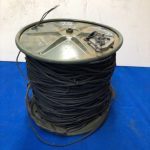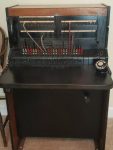Land-line analog telephone service was ubiquitous in most of the 20th Century. This hardware is now commonly Plain Old Telephone Service (POTS). This was our primary means of communication. It was simple, robust, and reliable. A few users still have landline service, although most landline service has migrated to digital means over a public Internet connection, with a modem at the user’s residence converting the digital data back to analog and providing ringer voltage to operate the bell. A lot of these telephones and associated equipment still exist, and are sitting in basements and attics. They could be easily pressed into service in a grid-down or SHTF scenario to provide communications.
Most “prepper” communication advice steers you to two-way radios, whether GMRS (General Mobile Radio Service), FRS (Family Radio Service), or Amateur (“ham”) radio. The downside of any radio-based communications system is a lack of privacy (ability to be easily monitored), and power required at each radio to make it function. Landline telephone, on the other hand, requires an actual physical connection or ‘tap’ to a user’s phone line to intercept the conversation, and functions from a central source of power, instead of requiring power at every user station.
Without getting too far down ‘into the weeds’ with technical details, POTS lines used 48 volts DC to provide the power for talking, and 90 volts AC at 20 cycles to operate the ringers. [This is often called “Ringing voltage.”] At 48 volts of talk voltage, a standard POTS line is good for service out to 18,000 feet, or over three miles. Larger gauge wire and other techniques can extend that out to 50,000 feet or so (almost ten miles). Conversely, POTS telephone instruments will work on much lower voltages if you are not trying to talk for miles and miles.
The functions of interconnecting the phones, such as providing the talk and ring voltages, were done by the phone company. However, you can easily substitute your own source of power that was provided by the phone company, with just a little simple electrical knowledge.
If you don’t have military field telephones, two traditional POTS line telephones can easily be connected to carry on a conversation with only a standard nine-volt DC battery, as shown below. L1 and L2 are the line terminals on the phones that connected to the incoming phone line. In a phone with a modular connector and cord on it, L1 and L2 may be identified as red and green in the modular jack. In a phone that is old enough to have the old-style non-modular cord on it, L1 and L2 are probably the red and green wires when you strip back the insulation on the cord:
This does not allow for ringing, but will allow you to talk back and forth. The current required is only about 15 mA at 9 volts, and it only draws current when both phones are off-hook, so even a small battery would last a long time.
More than two phones can be connected together in a ‘party line’ arrangement by using an inductor in series with the battery.
The current required is higher here as the phones are wired in parallel, but will still only be around 20 milliamps per phone, and will be limited to how many phones are off-hook at a time. The battery and inductor (coil) can be located separately from any of the phones:

An inductor or coil is an electrical component that passes direct current (the battery voltage to operate the phones) but blocks alternating current (the conversation) so it appears across all of the phones. The inductor is necessary to build the talking signal across – without it, you will be able to hear yourself in your phone, but you won’t be able to hear anyone else, and they will not be able to hear you. The inductor can be the primary of most any 120-volt AC-powered transformer, like a doorbell transformer, or the line power input to a wall wart (an older one with a transformer inside, not a newer one with a switching power supply). To check if the transformer or wall wart is usable, measure across its primary terminals with an Ohmmeter to check its internal resistance. If the DC resistance is less than 100 Ohms or so, then it should work just fine.
Telephone line
The cable to interconnect the phones does not have to be very heavy gauge (large in diameter), as the currents required are very small. Military single-pair telephone wire is available at many surplus stores under the designation WD-1 or WD-1A. The standard size spool (assuming it is still all there) is .5 kilometers, or around 1600 feet, and there is also a handy winder available to rewind it after use.
The standard spool of cable:

And the spool winder:

The cable can often be found for as little as $50/spool, and the winder is generally around $15.
MORE SOPHISTICATED COMMUNICATIONS
Obviously, these simple measures lack the ability to have communications privately with more than one user at a time, to communicate selectively with more than one user, or to signal a willingness to converse by taking the subscriber’s phone instrument off-hook. A more complicated system is necessary to allow these functions. While an automatic private branch exchange (or PBX) is beyond the ability of most non-technical people to set up and operate, and its survival after an EMP event is doubtful as well, there are other ways. Conventional manual telephone switchboards can often be found on Ebay, Facebook Marketplace, and at antique stores. A common one is the Western Electric Model 555, shown below:

These were common in offices and businesses in the first half of the 1900s. They allowed individual users to talk to each other, and could also interface to outside POTS lines, requiring the receptionist or operator to dial the calls and control long-distance access. They are quite simple. The only solid-state devices in them are diodes. Switching is done with mechanical switches, relays, and patch cords, which should survive an EMP event. The systems are modularized and were optioned and configured as required by the size and demands of the business or office where they were used. A fully “loaded” 555 could handle up to 60 subscriber stations (phone extensions), 14 central office lines, and handle 15 individual conversations. During a grid-down event the central office line capability might not be useful, but the ability to interconnect standard user telephones for discreet untraceable communications would be huge. The switchboard can be battery powered, and most included a ringing magneto to provide 90 volts alternating current for the ringers.
Basically, the switchboard does five things:
- It provides DC talk voltage to make the user’s phones work, from a central location – the individual users do not have to have a battery or power supply to make the phones function.
- It detects when a user’s phone is off-hook and the user wants to make a call. (The light bulb associated with that extension lights, and a buzzer rings to tell the operator someone wants to make a call).
- It allows the operator to talk to that user and determine what extension they wish to be connected to.
- It allows the operator to connect to the desired extension and ring that user’s phone to indicate they have an incoming call.
- It alerts the operator that the conversation is finished when the users hang up their phones, so that the operator can disconnect them and be ready for the next call.
In addition, in a SHTF scenario, it allows the individual user to discreetly signal that they need help by simply taking their phone off the hook. It also allows the operator to break into a conversation to alert the users that an emergency situation may be developing that they may not be aware of.
As I mentioned earlier, the switchboards are modularized. They can have up to six individual subscriber (user phone) input modules with 10 users each. They can have up to 14 POTS line modules, one for each incoming central office phone line. They can have up to 15 individual cord sets which are used to manage one conversation each. The different modules are easily removable and plug into the main frame of the switchboard, with quarter turn fasteners to secure them mechanically.
![]() The real “guts” of the switchboard are contained in the cord sets. This is where the calling- and called-parties are connected together for a conversation. Here is a closeup view of one of the cord sets.
The real “guts” of the switchboard are contained in the cord sets. This is where the calling- and called-parties are connected together for a conversation. Here is a closeup view of one of the cord sets.
There is a lamp and a ringing pushbutton associated with each cord. The indicator lamp lights to indicate that the extension that the cord is plugged into has put their phone back on-hook, I.e. they are finished with the conversation. The black pointer knob at the bottom, when turned to the right, connects the operator’s headset into the cord path to converse with the extensions connected together with the cords.
Briefly, the operation is as follows: When a subscriber wishes to make a call, they take their phone off-hook. This lights the lamp above that subscriber’s jack on the switchboard, and the buzzer sounds to alert the operator that attention is needed. The operator plugs the right-hand cord of the pair into that subscriber’s jack, turns the knob to the right to connect their headset into the path, and asks the calling party what extension they want to call. The operator then inserts the left-hand cord into the jack for the subscriber they wish to reach, and the operator rings that extension by pushing the left-hand ringing button. When the called party answers, the indicator light goes out, and the operator then leaves the conversation by turning the pointer knob back up to vertical. When the conversation is finished, the indicator lights below the cords light up when each subscriber hangs up their phone, and the buzzer sounds again, to alert the operator to unplug the cords in preparation for the next call.
Here is a rear view of the unit, where connections are made:

The tall grey metal boxes in the middle of the picture are the back of the cord sets (one cover is missing). Power connections (DC talk voltage and ringing voltage) are made through the terminal blocks at the bottom rear. Input connections are also made through the terminal blocks at the bottom, and the 25 pair standard phone connectors below them (there are three shown in the picture). These can be easily broken out with a standard 66-block to 25 pair connector, shown here:

50 conductor (25 pair) cables of various lengths with connectors already attached can be found from a number of suppliers, including eBay, enabling you to separate the switchboard and your wiring connection point as much as desired.
A few things to watch if you are going to try this:
- The switchboards could be set up to run on either 24 or 48 volts. (The common telephone company voltage was 48). If you don’t know what voltage your switchboard is configured for, pull out one of the indicator lamps and see what number it is (the slide base bulbs are identified by their voltage and then the letters PSB. A 24 volt bulb is a 24PSB and a 48 volt bulb is a 48PSB). You can also apply the lower voltage first and see how the board works. If the bulbs are dim and the relay action is sluggish, you probably need to go up to the higher voltage).
- If you don’t want to manually crank the magneto on the front to ring the user’s telephones, you can supply ringing voltage from an external supply. 90 volt, 20 cycle ringing voltage supplies are available with a variety of input voltages, from many different sources. Again, eBay is your friend.
- Before you buy a switchboard, look it over carefully to see if it has been hacked. A lot of the boards were removed by non-technical people that just cut every wire in sight indiscriminately, for non-functional use as stage props or displays. There may be some wires floating loose for adding extra input modules, but these should be laced up and insulated, not with bare wires hanging loose.
- These units are quite heavy. They were built back in a time when real steel was used to build something that would last for the next millennium. If you need to move it, removing the various modules will make it much easier to move, and also familiarize you on how the different modules are installed in the board. Holes in all four corners of the bottom of the steel frame make it easy to put the unit on casters for easier mobility.
There were many other manufacturers and models of phone switchboards other than the Western Electric 555 – Stromberg-Carlson is one, and Western Electric made several other models as well. An Internet search should turn up operation and repair data on other models if you find a different one in serviceable condition.
OUTDOOR WIRING
Back when POTS lines were common, single pair direct burial cable was common. Now, it is getting increasingly hard to find at a reasonable price. At my BOL, I have a 555 switchboard, and I have trenched direct burial cable from the house to the property line in the three directions where there are neighbors, for connection to WD-1 single pair cable for each subscriber in a SHTF scenario. I have found the most cost-effective solution for this is direct burial Category 5 or 6 computer network cable, which has four pairs of wires to provide a standard TCP-IP computer network interface, and can thus handle four POTS subscribers. An Internet search found 325 feet (100 meters) of direct burial Category 6 cable for just $65, or 1,000 feet for $170. At $.20/foot or less, this is a fairly inexpensive way to go, especially considering that each run of Cat 5 cable can handle four phone lines.
Conclusion
As we preppers all know, putting all your eggs in one basket is a formula for failure. Secure communication will be a vital part of survival when the SHTF. When we think of communications, too often we think of wireless ones, not realizing the pitfalls they have. It is tragically easy to think that no one is listening to your conversation on a walkie-talkie, especially on in the public FRS, GMRS, and even CB and amateur bands where radios are easily obtainable by the public. Having a way to communicate with a hard-wired system makes secure communications easier. Good luck and God bless!
—
JWR Adds: All of the foregoing is good guidance for situations where you don’t have access to military specification field telephones. Unlike civilian POTS phones, military surplus phone gear is far more weatherproof, robust, and designed for easy transport and quick connection/disconnection. It is all designed to be “Grunt-Proof”. Analog military field phones — such as the TA-1 and TA-312 or their European Ally equivalents — can be set up with small, simple military surplus switchboards such as the SB-22. And note that the more expensive military specification digital field telephones (such as the TA-1042 Digital Non-Secure Voice Terminal (DNVT) do not require a switchboard.
For some further reading, start with this article in the blog archives: U.S. Military Field Phones, by Ken in Michigan.
Read the full article here

